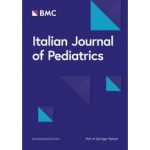Not just Alagilla syndrome. Syndromic insufficiency of the interlobular bile ducts, secondary to HNF1β deficiency: a case history and review of the literature.
 BACKGROUND:
BACKGROUND:
The lack of interlobular bile ducts is an important observation in liver biopsy in the diagnosis of cholestasis in newborns. So far, in addition to Alagilla syndrome, the syndromic insufficiency of the interlobular bile ducts has been documented in four cholestatic newborns with HFN1β mutations.
A syndromic phenotype, known as renal cysts and diabetic syndrome (RCAD), has been identified. It is usually characterized by a wide clinical spectrum, including renal cysts, mature diabetes in the young, exocrine pancreatic insufficiency, urogenital abnormalities, and poorly established liver damage. Here we report a new case of interlobular bile duct insufficiency due to a HFN1β defect.
PRESENTATION OF CASE:
A five-week-old boy entered our department for cholestatic jaundice with elevated levels of gamma-glutamyltranspeptidase and an unremarkable clinical examination. It was delivered by caesarean section at the 38th week of pregnancy from unrelated parents with a birth weight of 2600 g (3rd percentile).
Screening for cholestatic diseases, including Alagilla syndrome, was negative, with the exception of a minor stenosis of the pulmonary artery during echocardiography and doubts about the hemorteum of the thoracic butterfly. An ultrasound examination of hyperechoic kidneys with multiple bilateral cortical cysts associated with moderately impaired kidney function with proteinuria, polyuria, and metabolic acidosis suggests ciliopathy.
A liver biopsy was performed to identify the deficiency of the interlobular bile duct, thus, the diagnosis of Alagilla syndrome was revised. Although genetic tests for cholestatic liver diseases were performed with negative results for Alagilla syndrome (JAG1 and NOTCH2), the missense mutation of the de-novo HNF1β gene was found. At 18 months, our patient has persistent cholestasis, and his itch is not under satisfactory control.
FINDINGS:
Alagilla syndrome may not be the only syndrome that determines the deficiency of the interlobular bile duct in newborns with cholestasis and renal failure, especially in newborns with low gestational age. We suggest that HNF1β deficiency should also be excluded, taking into account HNF1β mutations together with Alagilla syndrome, in next-generation sequencing strategies in newborns with cholestasis, renal insufficiency and / or interlobular bile duct insufficiency in liver biopsy.
Pinon M, Carboni M, Colavito D, Cisarò F, Peruzzi L, Pizzol A, Calosso G, David E, Calvo PL.
Ital pediatrician. February 21, 2019; 45 (1): 27
doi: 10.1186
